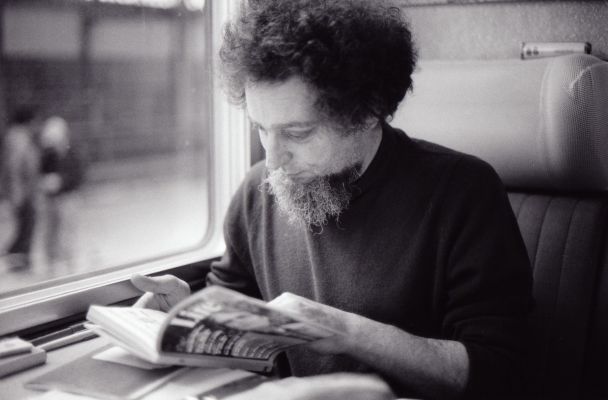3 Fantastic Experiments + 1 New Way of Seeing: Georges Perec

Georges Perec seems to be coming into a kind of fashion here at the top end of the 21st century. The under-translated OuLiPian Parisian created remarkable constraints from project to project in order to be more totally creatively abandoned. It worked. And serves as inspiration for others now. This is not even to make mention of his lipogram detective novel of over 50,000 words, which never once uses the letter “e,” La Disparition.
Why the timing is better now than in years prior has everything to do with technology. Technology that leads us to greater accessibility of previously arcane writers. Technology that is disrupting the publishing industry and leading increasing numbers of literary writers to seek other means of creating something new (since, after all, it’s not like they’re going mass market). Technology also that leads us to consider the interplay and exchange of ideas between games and storytelling, and how 
The first book I read of Perec’s was perhaps an appropriate backwards entry point: a novel that had gone unpublished in his lifetime. Somehow, I came across it while reading about games and literature.
The Art of Asking Your Boss for a Raise, translated by David Bellos, is not exactly hypertext and not exactly a choice-driven-result outcome either. Bellos also gives us an introduction and some of the background.
“In 1968, Jacques Perriaud, a researcher at the Computing Service of the Humanities Research Centre in Paris, came up with the idea to challenge an artist to write within a constraint that approximated the limitations of a computer’s operations, by following or imitating a series of algorithms. The algorithms for the scenario—seeking a raise from one’s boss—were presented to Georges Perec as a flowchart. Perec made some edits to the chart (reproduced at the beginning and end of the book), went off, and produced fifty pages of uncapitalized, unpunctuated and unparagraphed text.”
While this characterization may sound like a lot of the literary navel-gazing one has come to be familiar with in today’s publishing and writing climate, it’s not. It’s an amazing achievement of speed and combinatorial patterns, which on a first read you have to roll through and over and re-start and re-configure, which has very much the effect of mechanized configurations. And it’s got an edge of satiric wit that helps propel the engine. It’s not quite the same engine that runs a story like David Foster Wallace’s Oblivion but it certainly sets the stage for such literature. Thematically, it’s virtually identical.
What is seemingly surface and mundane and dehumanizing ends up having a powerful after-effect. You go back and re-read suddenly conscious of questions never directly asked. In particular, the cumulative effect of the poor soul trapped within his endless questions and neuroses, one is left to realize that he is not going to achieve his goals no matter what he does, but there is a glimmer of hope: to persist, to persevere. That at least is an option, even if may be the only one.
My second Perecs “attempt” led me to an overcast weekend in October 1974. Perec sets out in quest of the “infraordinary”: the humdrum, the non-event, the everyday–what happens, as he puts it, “when nothing happens.” His choice of locale was Place Saint-Sulpice, where, ensconced behind first one cafe window, then another, he spends three days recording everything to pass through his field of vision: from the people walking by to buses to a wedding (and then a funeral) at the church in the center of the square, “signs, symbols and slogans littering everything, and the darkness that finally absorbs it all,” as translator Marc Lowenthal puts it. An Attempt at Exhausting a Place in Paris is melancholic and probably exhausting to an impatient reader at first. Over “time” it becomes an eerie and touching document in which the line between the empirical and the surreal grows thin.
An Attempt is a friendlier gateway to his 600-page, denser Life: A User’s Manual, which thematically, the two pair together. Time is the centerpiece. The late oulipean Anthony Burgess complained that “La Vie mode d’emploi, for all its manifest genius, was a cold and heartless book.” It does become “less a delightful game and more like a frightening obsession,” as Kevin Jackson wrote in 1994 on Perec’s oulipian oeuvre. The function of the constraint, however, becomes a form that the subject matter must wrestle with, and that alone makes it a part of the entertainment.
In both, time is unarrestable, and for however sympathetic any such effort to “see everything” may be (Raymond Queneau famously pronounced that writers’s “must see everything”), what seems on the surface to be nothing becomes everything. Every bus that passes, every sandwich eaten, pigeon bobbing, every light that changes, every event–everything that does and does not happen marks the erosion of permanence. Paradoxically, one gets a sense of how very much the same a place might be in its rhythms and patterns from one generation to the next.
Here is a really cool one-minute video on “how to observe.”


One Response to “3 Fantastic Experiments + 1 New Way of Seeing: Georges Perec”
There are some interesting closing dates on this article however dedecebffdgf